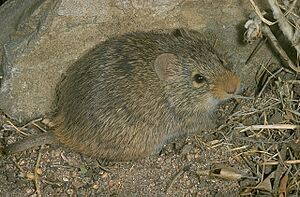Yellow-nosed cotton rat facts for kids
Quick facts for kids Yellow-nosed cotton rat |
|
|---|---|
 |
|
| Conservation status | |
| Scientific classification | |
| Genus: |
Sigmodon
|
| Species: |
ochrognathus
|
The yellow-nosed cotton rat (Sigmodon ochrognathus) is a type of rodent, which is a small, furry mammal like a mouse or a squirrel. It lives in Mexico and parts of the United States, including Arizona, New Mexico, and Texas. You can find these rats in mountain grasslands, bushy areas, and forests with pine and juniper trees. They are quite common in their homes, so experts say they are not currently at risk of disappearing.
Contents
What Does the Yellow-Nosed Cotton Rat Look Like?
Male yellow-nosed cotton rats can grow to about 155 mm (6 in) long, not counting their tail. Females are a little shorter but weigh more. In the wild, males and females look very similar.
This rat has a short, wide head. Its tail is covered in hair and has many tiny scales. The fur on its head, back, and sides is a dull gray color. What makes this rat special is its snout (nose area) and the ring around its eyes, which are a yellowish-orange color. This yellow color helps tell it apart from other cotton rats. Its belly is grayish-white, and its feet are grayish-buff. The top of its tail is blackish, and the underside is gray.
Where Do Yellow-Nosed Cotton Rats Live?
The yellow-nosed cotton rat lives in Mexico and the southwestern United States. In Mexico, its home stretches from the eastern side of the Sierra Madre Occidental mountains to central Durango and western Coahuila. In the United States, it lives in Arizona, New Mexico, and some desert mountains in Texas.
These rats prefer mountainous areas. They like grassy meadows, rocky slopes, and areas with shrubs. They also live in forests with ponderosa pine, Douglas fir, and pinyon-juniper trees. You usually find them on lower, drier slopes below 1,950 m (6,400 ft) in height. This species is the best at living in dry places among all cotton rats.
Reproduction and Life Cycle
Yellow-nosed cotton rats often build their nests inside thick clumps of grass or other dense plants. Their nests are made of grass and are about 18 to 40 cm (7 to 16 in) wide.
Female rats can start having babies when they are about 45 days old. Pregnancy lasts about 34 days. Usually, a mother rat gives birth to two to six young ones in a litter. The babies are born quite developed and can leave the nest soon after birth. Their eyes open on their first day, and they grow very quickly. They stop drinking their mother's milk when they are around 15 days old.
How Yellow-Nosed Cotton Rats Live in Their Habitat
The yellow-nosed cotton rat doesn't compete well with other types of cotton rats. If their homes overlap, the yellow-nosed cotton rat will live in rocky areas with thin plants and grass clumps.
In Arizona, you can often find them on open slopes among scattered trees like Emory oak and Arizona oak. They also live near plants like alligator juniper, yucca, agave, mimosa, sugar sumac, prickly pear, and desert spoon. These plants often have long leaves at their base, which the cotton rat uses for cover. This rat shares its home with other animals like the fulvous harvest mouse and the southern pocket gopher. It even uses burrows made by the gophers or spaces under large rocks for shelter.
When the yellow-nosed cotton rat is the only type of cotton rat in an area, it lives in grassy meadows and flat areas where the soil is deeper. In these places, it makes paths through the grass. However, in areas with fewer plants, these paths are hard to see.
These rats are mostly active during the day. They move quickly along their paths to avoid being caught by predators. They mainly eat blue grama grass, but they also eat other green plants like muhly, three-leaf groundsel, gumweed, and three-awn tangle-head. Sometimes, they eat seeds and fruits. They cut pieces of grass and make small piles on the ground. They also store dried plants underground, often in old burrows of southern pocket gophers.
Are Yellow-Nosed Cotton Rats Safe?
The yellow-nosed cotton rat lives in a large area and is common in many parts of its home. Scientists believe there are many of these rats in total. Even though their numbers might be going down in some places, they are spreading to new areas in others. Because of this, experts say the yellow-nosed cotton rat is not currently in danger of disappearing.


